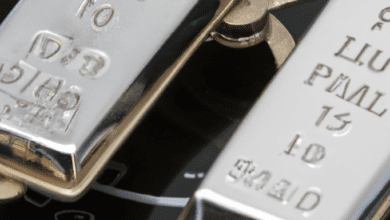Metals at the Crossroads: Exploring Industrial Demand, Investment Strategies, and Economic Indicators

In an era defined by rapid technological advancement and shifting economic landscapes, the role of metals has become increasingly multifaceted, influencing both industrial applications and investment strategies. This article delves into the complex interplay between various metals and their significance in today’s markets. From silver's dual function as an industrial workhorse and an investment vehicle to copper's status as a barometer of global economic health, we explore how these materials reflect broader trends. Additionally, we examine the surge in demand for rare earth metals driven by green energy technologies, the competitive dynamics between platinum and palladium as investment options, and the crucial role metals play in diversifying investment portfolios. As inflation continues to challenge traditional asset classes, we analyze its impact on the prices of precious and industrial metals, the evolving future of aluminum in a sustainable economy, and the implications of mining regulations on market fluctuations. Join us as we navigate the intricate world of metals, revealing how they shape our economic realities and investment opportunities.
- 1. **Metals in Motion: Navigating Industrial Demand and Investment Trends**
- 2. **Economic Indicators: How Metal Prices Mirror Global Health**
- 3. **The Green Revolution: Shifting Demand for Rare Earth Metals and Its Implications**
1. **Metals in Motion: Navigating Industrial Demand and Investment Trends**
Metals play a pivotal role in both industrial applications and investment strategies, creating a dynamic landscape that reflects broader economic trends. As various industries advance, the demand for metals fluctuates, influenced by technological innovation, geopolitical factors, and market sentiments.
In the industrial sector, metals such as copper, aluminum, and rare earth elements are essential for manufacturing, construction, and energy production. For instance, copper is a critical component in electrical wiring and renewable energy systems, making its price a barometer for global economic activity. When economies expand, the demand for copper typically rises, leading to increased prices. Conversely, during economic downturns, industrial demand can wane, resulting in lower prices and, consequently, a reflection of decreased economic health.
On the investment side, metals are often viewed as tangible assets that can provide a hedge against inflation and currency fluctuations. Precious metals like gold and silver are traditionally seen as safe havens during economic uncertainty, attracting investors looking to preserve wealth. In contrast, industrial metals can offer growth potential, closely tied to economic cycles and infrastructure developments. Investors must navigate these trends, balancing the immediate needs of industrial markets with long-term investment strategies.
Furthermore, the rise of green technologies has introduced new demand for specific metals, particularly those critical for batteries and renewable energy systems. This shift not only affects market prices but also influences investment decisions, as investors seek to capitalize on the growth of sustainable industries.
Ultimately, understanding the interplay between industrial demand and investment trends is crucial for stakeholders in the metals market. As economies evolve and new technologies emerge, the movement of metals will continue to reflect broader economic conditions while presenting unique opportunities for investors.
2. **Economic Indicators: How Metal Prices Mirror Global Health**
Metal prices serve as a critical barometer for assessing global economic health, reflecting a myriad of economic indicators that influence supply and demand dynamics. When economies grow, industrial activity typically increases, leading to higher demand for metals such as copper, aluminum, and steel, which are essential for manufacturing, construction, and infrastructure development. This increased demand often drives prices upward, signaling robust economic performance.
Conversely, during periods of economic downturn or recession, demand for industrial metals tends to decline as production slows and construction projects are postponed or canceled. This relationship is particularly evident in copper prices, which have long been regarded as a leading indicator of economic health, earning it the nickname “Dr. Copper.” Analysts closely monitor copper price movements to gauge the health of sectors such as housing and manufacturing, as a drop in prices may indicate waning economic activity.
Moreover, geopolitical factors, trade policies, and currency fluctuations can further impact metal prices. For instance, tariffs or trade restrictions can disrupt supply chains, leading to price volatility. Similarly, a weakening currency can increase the cost of imported metals, influencing domestic prices.
In addition to industrial metals, precious metals like gold and silver also reflect economic conditions, albeit in different ways. Gold is often viewed as a safe haven during times of economic uncertainty or inflation, driving up its price when investor confidence wanes. In contrast, silver tends to follow both industrial demand trends and its role as a precious metal, making it more sensitive to fluctuations in economic sentiment.
Overall, the intricate interplay of these factors underscores the importance of metal prices as a reflection of global economic health, making them vital indicators for investors, policymakers, and businesses alike. As such, closely monitoring metal price trends can provide valuable insights into the broader economic landscape.
3. **The Green Revolution: Shifting Demand for Rare Earth Metals and Its Implications**
The increasing focus on sustainability and the transition to green energy technologies are driving a significant shift in the demand for rare earth metals. These metals, essential for the production of high-tech devices, renewable energy systems, and electric vehicles, are becoming more critical as industries strive to reduce their carbon footprints. Rare earth elements (REEs) like neodymium, dysprosium, and lithium are vital for manufacturing powerful magnets used in wind turbines and electric motors, as well as in batteries for electric vehicles and energy storage systems.
As governments and companies commit to ambitious climate goals, investment in clean energy technologies is surging, resulting in heightened competition for these scarce resources. This rising demand could lead to supply chain vulnerabilities, especially as most rare earth metals are mined in a limited number of countries, predominantly China. Such concentration raises concerns about geopolitical risks and the potential for supply disruptions, which could drive up prices and impact the overall cost of green technologies.
Moreover, the increased demand for rare earths has implications for environmental sustainability. Mining and processing these metals can have significant ecological impacts, including habitat destruction and pollution. Therefore, it is crucial for industries to adopt responsible sourcing practices and invest in recycling technologies to mitigate these effects.
In summary, the green revolution is reshaping the landscape of rare earth metal demand, presenting opportunities and challenges. As the world shifts toward a more sustainable economy, the strategic management of rare earth resources will be essential to ensure both environmental protection and technological advancement.
In conclusion, the intricate landscape of metal markets reveals a multifaceted relationship between industrial demand and investment opportunities. Silver continues to play a dual role, serving both as a critical component in various industries and a sought-after asset for investors. The fluctuations in copper prices serve as a barometer for global economic health, while the rise of green energy technologies underscores the increasing significance of rare earth metals in the transition to a sustainable future.
As we navigate the complexities of platinum versus palladium, it becomes clear that each metal offers unique advantages depending on market conditions and investment strategies. Diversification remains a key principle for investors, with precious and industrial metals providing a hedge against inflation and economic uncertainty. The future of aluminum looks promising as industries pivot towards sustainable practices, and the ongoing impact of mining regulations will undoubtedly shape the prices and availability of these essential resources.
Overall, understanding the dynamics of metal markets is crucial for investors and industries alike, as these elements not only reflect current economic trends but also pave the way for future innovations and sustainability efforts. By staying informed about these developments, stakeholders can better position themselves to capitalize on opportunities and navigate potential challenges in this ever-evolving sector.





